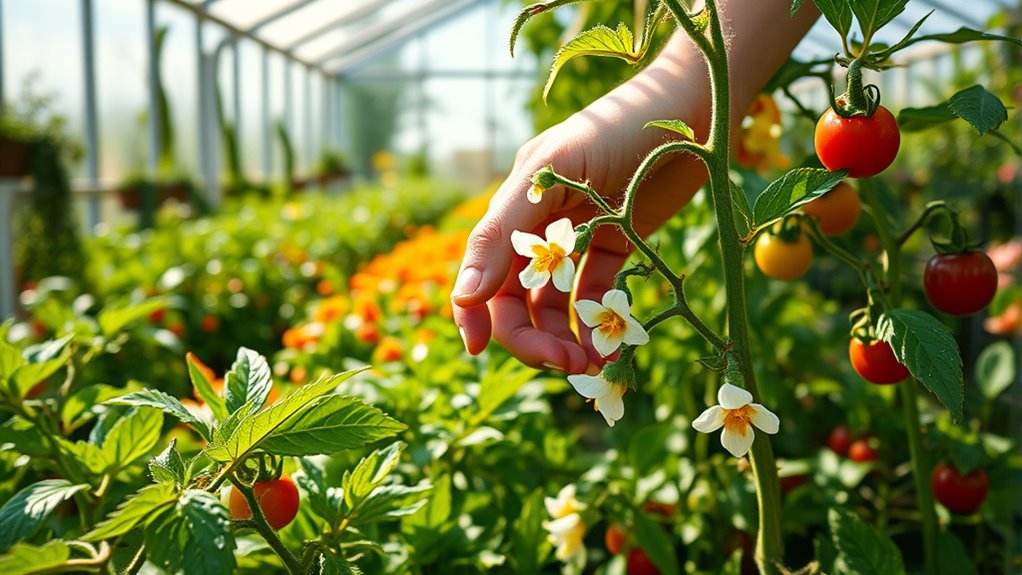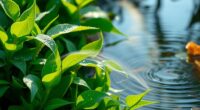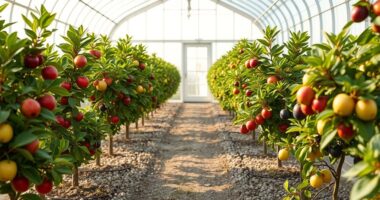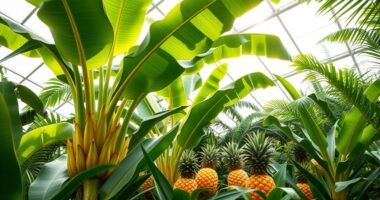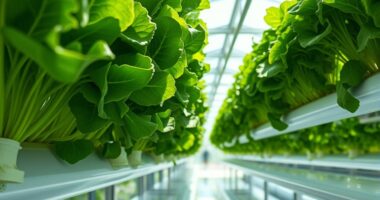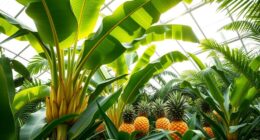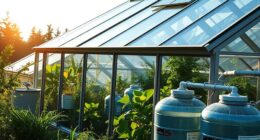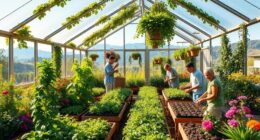To help your greenhouse plants fruit, encourage natural pollinators like bumblebees or honeybees by creating a friendly habitat with flowers, shelter, and nectar sources. When natural pollination is limited, use manual techniques such as gentle shaking flowers or using brushes to transfer pollen. Combining these methods boosts fruit set, quality, and uniform ripening. Continuing figures out more ways to optimize pollination and improve your crop yields.
Key Takeaways
- Encourage natural pollinators like bumblebees by creating a habitat with flowering plants, shelter, and nectar sources.
- Supplement with manual pollination using brushes, vibrators, or gentle shaking if natural pollinators are scarce.
- Time manual pollination during peak flowering to maximize fertilization and fruit set.
- Maintain a clean, healthy greenhouse environment to attract and sustain pollinators naturally.
- Combine natural and manual methods for optimal pollination, improving fruit quality and uniform ripening.
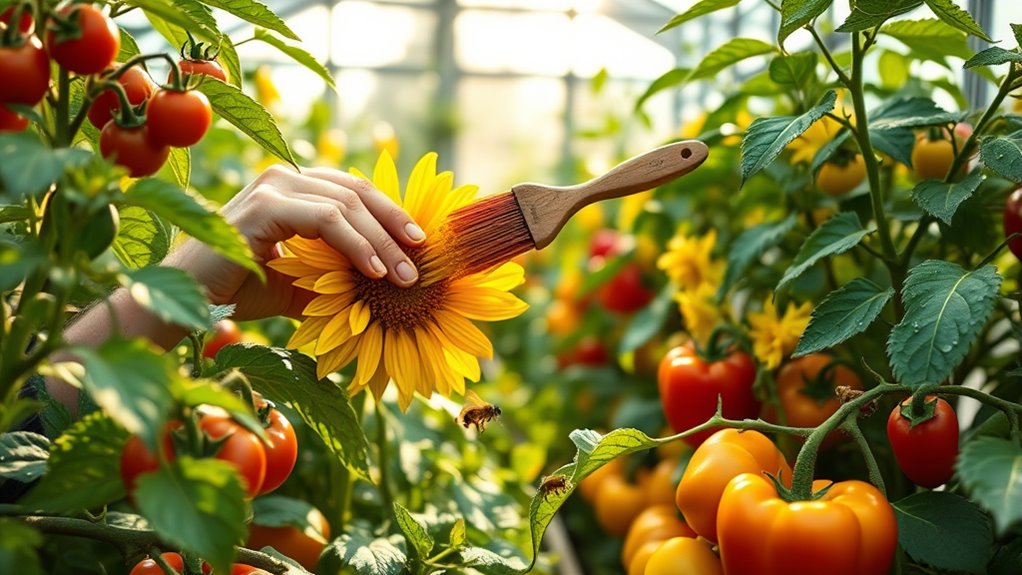
Pollination in the greenhouse is a crucial process that guarantees healthy fruit and flower production. Without proper pollination, your plants may produce fewer or deformed fruits, or even fail to set fruit altogether. To optimize this, understanding indoor pollination techniques becomes essential. These methods involve manually transferring pollen from one flower to another, often using tools like brushes or vials, to mimic natural pollination. You might also employ vibrators or small fans to shake flowers gently, encouraging pollen release. While these techniques can be effective, they require consistent effort and attention to detail.
Manual pollination techniques, like brushing or vibrators, help ensure fruit set when natural pollinators are absent.
However, one of the most beneficial strategies is to harness the benefits of natural pollinators within your greenhouse environment. Introducing or attracting pollinators like bumblebees, honeybees, or even native insects can dramatically improve pollination success. Natural pollinators are highly efficient because they instinctively know how to transfer pollen between flowers, increasing fertilization rates and leading to better fruit set and larger yields. They also reduce your dependency on manual labor and technical devices, making the process more sustainable and cost-effective. Creating an inviting environment for these beneficial insects involves planting flowering plants that provide nectar and pollen, avoiding pesticides that could harm them, and offering shelter or nesting sites.
Implementing natural pollination strategies benefits your plants beyond just improved fruit production. Natural pollinators help maintain the health and diversity of your greenhouse ecosystem, which can lead to more resilient plants and fewer pest problems. Plus, relying on nature’s pollinators minimizes the risk of human error associated with manual pollination. Their activity often results in better fruit quality and more uniform ripening, key factors for commercial growers and hobby gardeners alike. Additionally, research shows that soil health directly impacts the effectiveness of pollination and fruit development. Supporting a healthy soil ecosystem can further enhance pollination efficiency and plant vigor. Creating a pollinator habitat within your greenhouse encourages sustained activity of beneficial insects and enhances long-term pollination success.
Of course, in some cases, manual techniques are necessary, especially if your greenhouse lacks sufficient natural pollinator activity or if you’re growing crops that are less attractive to insects. In those instances, regular manual pollination can supplement the efforts of natural pollinators or serve as the primary method. Using indoor pollination techniques, like hand-pollinating with brushes or employing small vibrators, can ensure your plants get the pollen transfer they need. Proper timing and consistent application are crucial for manual pollination to be effective.
Ultimately, combining natural pollinators with manual techniques offers a balanced approach that maximizes fruit and flower production. By fostering an environment that attracts beneficial insects and knowing how to manually assist pollination when needed, you give your plants the best chance to thrive and produce abundant, healthy fruits. Integrating pollination techniques into your greenhouse management can significantly improve crop yields and quality.
Frequently Asked Questions
Can I Manually Pollinate Without Experience?
You can definitely manually pollinate without experience by using simple hand pollination techniques. Start by gently transferring pollen from male to female parts of the flower using a small brush or cotton swab. Focus on pollination timing strategies, like doing it when flowers are most receptive, usually in the morning. With patience, you’ll improve quickly and help your plants fruit successfully, even as a beginner.
What Tools Are Best for Greenhouse Pollination?
They say, “A tool is only as good as the hand that wields it.” For greenhouse pollination, the best tools are soft brushes, small handheld vacuums, and gentle spray bottles. These pollination techniques mimic natural pollination and help transfer pollen effectively. Using quality greenhouse tools guarantees you can manually pollinate with precision, boosting fruit production. Keep your tools clean and gentle to avoid damaging delicate flowers.
How Often Should I Pollinate My Greenhouse Plants?
You should pollinate your greenhouse plants based on their pollination timing and frequency needs. Typically, pollinate when flowers open and are receptive, often daily or every other day during peak bloom. Keep an eye on flower stages to determine the right timing, and don’t overdo it—frequent pollination during flowering ensures better fruit set. Adjust your pollination schedule as plants progress through their flowering cycle for best results.
Are There Natural Pollinators Suitable for Greenhouses?
Imagine a gentle breeze carrying the hum of native bees through your greenhouse, naturally aiding pollination. Yes, there are suitable natural pollinators like native bees that thrive indoors if you create inviting environments. Incorporate native bee-friendly plants or nesting sites, and use gentle pollination techniques like hand shaking or using a soft brush. This boosts natural pollination, reduces reliance on artificial methods, and keeps your plants thriving with minimal effort.
How Do Temperature and Humidity Affect Pollination Success?
You should understand that temperature and humidity considerably impact pollination success. Since many plants are temperature sensitive, maintaining ideal temperatures ensures pollen viability and flower receptivity. Humidity control is equally important; high humidity can cause mold, while low humidity may dry out pollen. By carefully managing these conditions, you create an excellent environment that encourages effective pollination, leading to better fruit production in your greenhouse.
Conclusion
By actively assisting pollination, you can boost your greenhouse’s fruit yield considerably. Did you know that hand-pollinated plants can produce up to 30% more fruit than those left to natural pollination alone? So, don’t hesitate to gently shake flowers or use a brush to transfer pollen. Your effort makes a real difference, ensuring your plants thrive and you enjoy a bountiful harvest. Keep pollinating, and watch your greenhouse flourish!
